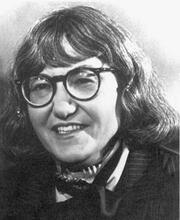Ruth Whitman
Born in New York City, Ruth Whitman graduated from Radcliffe College magna cum laude in 1944 and received her MA from Harvard University in 1947. Late in life, Whitman learned Yiddish, was a writer-in-residence at the Hebrew University, and received acclaim for her translations of the work of Yiddish poets, published in her Anthology of Modern Yiddish Poetry (1966, reissued with additional poems in 1995). In the 1970s, Whitman began a series of narrative poems written in the voices of women from the past, including Lizzie Borden, Tamsen Donner, Hanna Szenes, and Hatshepsut, the only woman pharaoh in ancient Egypt. In Hatshepsut, Speak to Me (1992), she explored problems with sexual identity, love, work, and motherhood that she and Hatshepsut shared. Whitman also taught at multiple schools including Radcliffe and M.I.T.
Overview and Early Life
“I keep my clocks a little fast / so time won’t take me by surprise,” wrote Ruth Whitman in “Round,” one of her early poems collected in Laughing Gas (1991). That collection of poems, chosen from thirty years of lyrical writing, records a life lived as a race against the clock. Whitman wrote her first poem when she was age nine and sold her first poem when she was age eleven. At age seventy, in Hatshepsut, Speak to Me, her eighth volume of poetry, she wrote, “I’m racing to leave behind / a few words arranged in a pattern / that will touch the living.”
Whitman’s autobiographical poems are about her journey through life, inspired by her experiences as a daughter, granddaughter, wife, and mother of two daughters and a son. Ruth (Bashein) Whitman, oldest daughter of Meyer David and Martha H. (Sherman) Bashein, was born on May 28, 1922, in New York City. Her brother, Harry Bashein, was born in 1927, and her sister, Nancy Baker Coe, in 1929. She had memories of her Russian-born grandfather singing Yiddish and Russian lullabies to her. As an adolescent, she read poetry avidly and was encouraged by her teachers in high school and college to write. She graduated from Radcliffe College magna cum laude in 1944 with a degree in Greek and English and received her MA in classics from Harvard University in 1947.
In 1941, she eloped with Cedric Whitman, a brilliant young classicist poet at Harvard University, and the couple had two daughters, Rachel and Lida. The marriage ended in divorce in 1958. A shorter marriage to Firman Houghton, during which her son David was born, ended in divorce in 1964. In 1966, she married Morton Sacks, the painter. She wrote of that marriage as her “homecoming.”
Translation and Poetry
Late in life, Whitman learned Yiddish, and a year as writer-in-residence at the Hebrew University (1984–1985) added yet another dimension to her Jewish life. There are Jewish poems in all her collections, but she received special acclaim for her translations of the work of Yiddish poets Jacob Glatstein and Abraham Sutzkever. Her excellent Anthology of Modern Yiddish Poetry, first published in 1966, was reissued with additional poems in 1995. It included translation of the Yiddish poetry of Celia Dropkin, Rokhl Korn, Anna Margolin, and Kadya Molodowsky.
In the 1970s, Whitman began her series of narrative poems written in the voices of women from the past. Lizzie Borden, the repressed nineteenth-century rebel; Tamsen Donner, who lost her life during an ill-fated trek west in 1864; Hanna Szenes, who was executed by firing squad after trying to rescue Hungarian Jews, including her mother, in 1943; and Hatshepsut, the only woman pharaoh in ancient Egypt. Whitman’s Hatshepsut, Speak to Me, a dialogue across twenty-five centuries, describes the problems with sexual identity, love, work, and motherhood that she and Hatshepsut share. She speaks to Hatshepsut as if she were her contemporary and tries to learn how to use her strength without fear.
Whitman’s subjects stem from her obsession with survival—her questions about how she would behave under life-threatening stress, whether she would be a victim or a survivor. She earned her living as a teacher and reader of poetry and received many awards, grants, and fellowships. Her teaching career began at the Cambridge Center for Adult Education in 1964. From 1969, she lectured on poetry at the Radcliffe Seminars and was a poet-in-residence on many campuses.
At the time of her death, Ruth Whitman lived in Middletown, Rhode Island, where the view of the Atlantic from her window provided peace and inspiration, and in Brookline, Massachusetts, accessible to students from the Radcliffe Seminars and M.I.T., where she was a visiting professor of poetry.
SELECTED WORKS BY RUTH WHITMAN
Anthology of Modern Yiddish Poetry, 3d ed. (1995).
The Fiddle Rose: Poems by Abraham Sutzkever (1990).
Hatshepsut, Speak to Me (1992).
Laughing Gas (1991).
The Marriage Wig and Other Poems (1968).
The Passion of Lizzie Borden (1973).
The Selected Poems of Jacob Glatstein (1973).
Tamsen Donner: A Woman’s Journey (1977).
The Testing of Hanna Senesh (1986).
Chametzky, Jules. "Ruth Whitman—Translations & Transformations." In Out of Brownsville: Encounters with Nobel Laureates and Other Jewish Writers, 94-99. University of Massachusetts Press, 2012.
Contemporary Poets; Rothchild, Sylvia. “Interview with Poet Ruth Whitman.” The Jewish Advocate, January 24, 1992.
Who’s Who in America.



